
Feeling more happy after a run? Or feeling a bit blue during the dark winter days? Regular exercising and regular daylight exposure can influence your mood, behaviour and sleep-wake cycle 1,2,3. But can this also be used in a therapeutical setting, for instance in addition to or instead of the usual treatment with medication? The PROUD trial aims to investigate the potential of bright light therapy and physical exercise to improve and prevent depression and obesity in adolescents and young adults with ADHD. This clinical trial is part of the CoCA research project, in which comorbid conditions of ADHD are investigated In addition, we collect the stool samples of all participants in order to investigate the effects of physical exercise on the gut microbiome and how this is linked to behaviour. That part of the study is part of the Eat2beNICE research project.
Most people with Attention Deficit Hyperactivity Disorder (ADHD) receive medication to reduce their symptoms4. While this medication works well for many people, there is a lot of interest in other types of treatment. One reason for this is that people with ADHD suffer from additional conditions, such as depression5 and obesity6. The risk for developing these comorbid conditions is especially high during adolescence and young adulthood4.
Adolescents and young adults (age 14-45) with ADHD that want to participate are randomly assigned to one of three groups: 10-weeks of daily light therapy (30 minutes), 10-weeks of daily physical exercise (3x per day) or 10-week care as usual (for instance, the normal medication). The random assignment is very important here in order to compare the different interventions. We don’t want to have all people that like sports in the physical exercise group, because then we don’t know if the effects of the physical exercise are due to the intervention, or due to the fact that these people just like sports better.
Another nice feature of the study is that it uses a phone app (called m-Health). This app is used to remind the participants to do their exercise or light therapy, but it also gives feedback and summaries of how the participant is doing. The app is linked to a wrist sensor that measures activity and light.
The clinical trial is currently ongoing in London (England), Nijmegen (Netherlands), Frankfurt (Germany) and Barcelona (Spain). We can’t look at the results until the end of the trial, so for those we will need to wait until 2021. But in the mean time the PROUD-researchers have interviewed four participants. You can read these interviews here:
- “I think the intervention was helpful for improving my physical condition and I was more tired so it helped me to sleep better. I also understood that my emotions and mood are important and that I have to take care of my mental health.” A young man in Barcelona tells about what it’s like to have ADHD, and how he experienced the physical exercise intervention: https://mind-the-gap.live/2018/10/09/adhd-awareness-month-interview-participant/
- “I am always doing research on mental health because it allows me to get a better understanding of what is happening on a more scientific level. It gives me more insight and allows me to better deal with my symptoms.” A participant in London also did the exercise intervention and shares his experiences: https://mind-the-gap.live/2018/11/08/living-day-to-day-with-adhd-and-experience-of-the-coca-clinical-trial/
- “I was hoping a side effect would be falling asleep faster but unfortunately this was not the case for me.” Nina from The Netherlands received the light therapy. You can read her interview here: https://mind-the-gap.live/2019/05/09/light-therapy-and-its-influence-on-adhd-an-interview/
- “During the 10 weeks of light therapy I felt much better in the mornings; it was easier to start the day and to get into the day.” A young woman from Frankfurt tells about how she experienced the light therapy: https://mind-the-gap.live/2019/02/28/proud-study-interview-with-participants-part-3-managing-adhd-with-light/
This blog is based on the blog “10 weeks of physical exercise or light therapy: what’s it like to participate in our clinical trial?” by Jutta Mayer and Adam Pawley, 9 Oct. 2018 on MiND the Gap – https://mind-the-gap.live/2018/10/09/10-weeks-of-physical-exercise-or-light-therapy/
References
- Terman, M. Evolving applications of light therapy Sleep Medicine Reviews. 2007; 11(6): 497-507.
- Stanton, R. & Reaburn, P. Exercise and the treatment of depression: A review of the exercise program variables Journal of Science and Medicine in Sport. 2014; 17(2):177-182
- Youngstedt, S.D. Effects of exercise on sleep Clinical Sports Medicine. 2005; 24(2):355-365.
- Cortese S, Adamo N, Del Giovane C, Mohr-Jensen C, Hayes AJ, Carucci S, et al. Comparative efficacy and tolerability of medications for attention-deficit hyperactivity disorder in children, adolescents, and adults: a systematic review and network meta-analysis Lancet Psychiatry. 2018;5(9):727-738.
- Jacob CP, Romanos J, Dempfle A, Heine M, Windemuth-Kieselbach C, Kruse A, et al. Co-morbidity of adult attention-deficit/hyperactivity disorder with focus on personality traits and related disorders in a tertiary referral center Eur Arch Psychiatry Clin Neurosci. 2007;257:309–17.
- Cortese S, Moreira-Maia CR, St Fleur D, Morcillo-Penalver C, Rohde LA, Faraone SV. Association between ADHD and obesity: a systematic review and meta-analysis Am J Psychiatry. 2016;173:34–43.
- Meinzer MC, Lewinsohn PM, Pettit JW, Seeley JR, Gau JM, Chronis-Tuscano A, et al. Attention-deficit/hyperactivity disorder in adolescence predicts onset of major depressive disorder through early adulthood Depress Anxiety. 2013;30:546–53
